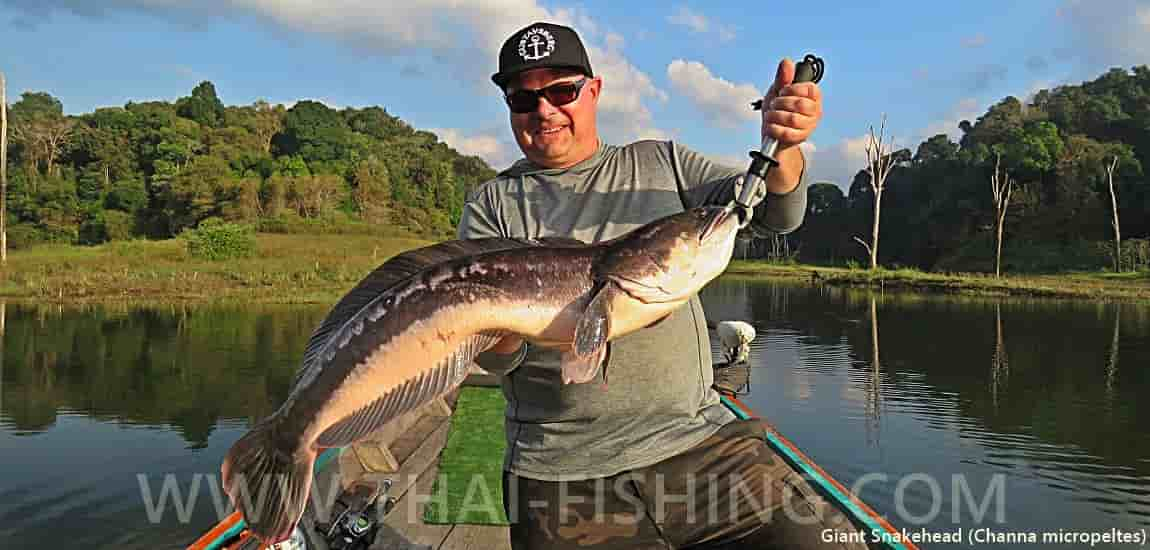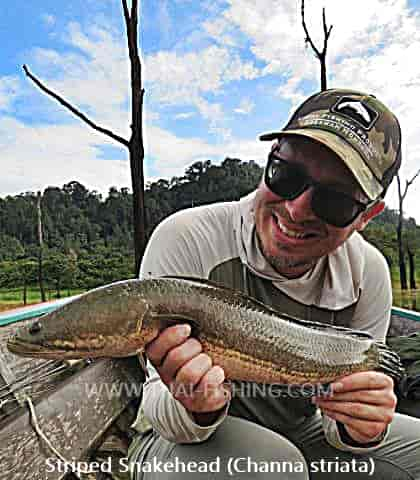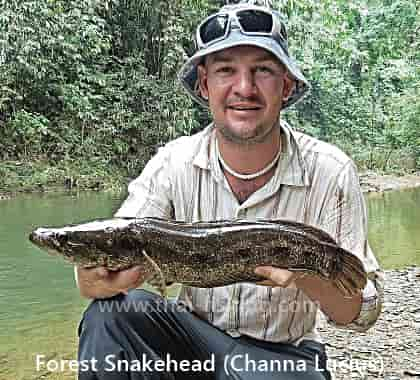
Snakehead Fish a Sport-fish in Thailand
Some of the Snakehead fish species are very popular freshwater sport fish in Thailand. Snakehead fishing is considered a thrilling and challenging activity for both local anglers and tourists. Lure fishing is a popular and exciting way to target these aggressive freshwater predators. Topwater lures can be particularly effective, especially during morning and evening when they are most active. Walk-the-dog style lures, poppers, and frog imitations are excellent choices for enticing surface strikes.
Snakehead are a species of fish that often lurks around structures like submerged vegetation, fallen trees, and shoreline cover. Cast your lures close to these structures. Experiment with different retrieve styles, such as slow and steady, fast and erratic, to see what triggers the most strikes. Snakehead can be unpredictable in their feeding behavior, so being versatile with your retrieve can increase your chances of success.
 Thailand is home to several Snakehead fish species that are interesting for anglers, including the Giant (Channa micropeltes). This species is known for its aggressive nature and is a highly sought-after game fish, for its size and fighting abilities. Striped (Channa striata). Great (Channa marulius). Emperor (Channa marulioides) and the Forest (Channa Lucius). The 5 species mentioned above, all live in the jungle waters of Southern Thailand. where we run our private fishing tours, you can read more about our Giant Snakehead fishing trips here
Thailand is home to several Snakehead fish species that are interesting for anglers, including the Giant (Channa micropeltes). This species is known for its aggressive nature and is a highly sought-after game fish, for its size and fighting abilities. Striped (Channa striata). Great (Channa marulius). Emperor (Channa marulioides) and the Forest (Channa Lucius). The 5 species mentioned above, all live in the jungle waters of Southern Thailand. where we run our private fishing tours, you can read more about our Giant Snakehead fishing trips here
Snakehead Fish (Channidae)
They are named for their snake-like appearance due to their elongated body and flattened head. There are 50 reported species of Channa and 3 species of Parachanna. The species of Channa refers to the genus in Asia and Parachanna refers to the genus in Africa. Both species are a part of the family Channidae, a group of predatory freshwater fish, native to parts of Africa and Asia, including countries like India, China, and Thailand
Their colors can vary depending on the species, age, environmental factors and time of year. However, many species have a dark or light brown, gray or blackish coloration or greenish tint. with a light-colored belly. Patterns on their bodies, like spots or stripes, which allow them to camouflage effectively in different surroundings. They also change color during the breeding season, again it depends on the species. As well what stage they are in the breeding process, will determine what color they have.
 Habitat
Habitat
Snakehead fish are a highly adaptable fish species and can thrive in a variety of aquatic environments. Including slow-moving rivers, ponds, swamps, and marshes. They often prefer areas with plenty of aquatic vegetation, submerged plants, and submerged logs or debris. These provide cover for them to ambush prey and avoid predators. Additionally, they can tolerate low oxygen levels and can survive out of water for short periods due to their ability to breathe air using their suprabranchial organ.
This organ allows them to “walk” or move over land for up to 4 days, if they stay moist, by using their pectoral fins. The ability to move over land is not true walking, but rather a form of wriggling or writhing motion. They can push themselves forward and move between bodies of water or across moist terrain. By flexing their bodies and using their pectoral fins to “crawl” along the ground. The ability to walk over land is not the primary mode of locomotion for Snakehead fish. They are predominantly aquatic and rely on swimming in water for their regular activities. However, because they can move over land, this has raised concerns in regions where these fish have been introduced as invasive species. As they can disperse to new habitats and negatively impact local ecosystems.
Snakehead Lifespan and Size
On average, Snakehead fish can live anywhere from 8 to 15 years. Some individuals have been known to live longer, up to 20 years or more, under favorable conditions. However, in the wild, their lifespan can be influenced by various factors. Including: species, quality of habitat, availability of food, competition, predation, and human activities.
The largest species is the Giant Snakehead which can grow to a considerable size. Adult individuals can reach lengths of over 1 meter (3.3 feet) and weigh up to 20 kilograms (44 pounds). The All-Tackle World Record for this species, is a massive fish of 13.6-kilograms (30-pounds). Caught outside of Rawang, Malaysia on February 28, 2018. The smallest species is likely the (Channa gachua), commonly known as the dwarf Snakehead. The name “dwarf ” is also used, for several other species of small Snakeheads. These species typically reach lengths of about 10 to 15 centimeters. All these species are native to Thailand and other countries in Southeast Asia.
 Diet
Diet
They are a voracious predatory fish and have a reputation for being aggressive hunters. Their diet can vary depending on their species, size, habitat, and availability of prey. Snakehead are known for preying on other fish. They are opportunistic hunters and can target a wide range of fish species present in their habitat. Larger species consume small mammals like rodents that come near the water, as well as frogs and lizards. There have been reports of them capturing and eating small birds that come close to the water’s surface. They are also known for their cannibalistic tendencies, especially when the population is dense, or resources are limited.
In their juvenile stages, the diet consists of zooplankton, insect larvae, and later, aquatic insects like aquatic beetles, water bugs, and other small insects. Crustaceans such as crabs, shrimp, and crayfish and amphibians such as tadpoles that inhabit the water. Can all be part of the diet and provide a good source of protein and nutrients.
Snakehead Breeding Timeline
They start spawning at different ages depending on the species and environmental conditions. Some species may start spawning as early as one year of age, while others may take longer, typically between two to three years.
Snakehead typically start breeding, at the beginning of the rainy season. The exact timing can vary depending on the specific species and the geographic region in which they are found. In their native habitats, male and female fish come together to spawn, in response to changes in temperature and environmental conditions.
The species is known for being a highly reproductive species, capable of laying many eggs. However, the exact number of eggs they lay varies based on several factors. Including the size and species, the age and health of the individual fish. Environmental conditions, and the availability of suitable spawning sites. In general, a mature female Snakeheads can lay anywhere from a few hundred to several thousand eggs in a single spawning event. Species, like the Northern Snakehead can lay thousands of eggs in a single clutch. In most of the species, will the parents exhibit remarkable parental care.
Nest Building
Snakehead are known to create nests for spawning, the nest-building behavior and location. can vary depending on the species and the habitat in which they are found. Some species construct more elaborate nests with plant materials, while others may simply create depressions in the substrate. Once the nest is constructed, they will be vigorously defended, when the eggs have been laid, the parent will fan the eggs with their fins to provide oxygen and prevent fungal growth. After the eggs hatch, the parents continue to provide care for the fry. They will help them find food, protect them from predators, and guide them until they are old enough to fend for themselves. This behavior enhances the survival rate of their offspring.
After the breeding season, they are likely to go their separate ways and may not maintain any long-term social bonds. There is a common misconception that Snakehead pair together for life, but this is not entirely accurate. Like many other fish species, they can exhibit some form of pair bonding during the breeding season. But they are not known for forming lifelong monogamous relationships.
 Snakehead As Invasive Fish Species
Snakehead As Invasive Fish Species
The Snakehead is indeed a notoriously invasive fish species that has garnered significant attention. They have been introduced to new areas/habitats. Often unintentionally through the aquarium trade or intentionally by individuals, looking to establish them as game fish. The introduction of Snakehead fish can have serious ecological consequences. Their predatory behavior can outcompete native fish for resources, leading to declines in native fish populations. The fish species are also known for their adaptability and hardiness, they can survive in a wide range of aquatic environments.
Several snakehead species have invaded various geographical locations, throughout the world. Including the USA, Canada, Europe and Asia.
United States:
Some species have gained significant attention in the United States. The Northern Snakehead (Channa argus) was discovered in Maryland in 2002. Were likely introduced through the illegal release of aquarium pets. The initial detection occurred in a pond in Crofton, which led to a swift response from local authorities. They have been reported in various areas in Maryland. Including the Potomac River, its tributaries, and other freshwater habitats such as lakes, ponds, and reservoirs.
It has since spread to other states, including Virginia, Pennsylvania, and Florida. Where it has established reproducing populations in freshwater habitats such as ponds, lakes, and rivers. Several species have been found in Florida, where especially the Bullseye Snakehead (Channa marulius), has spread wildly. Multiple species have been found in Pennsylvania. With the northern Snakehead being one of the most notable and one of the main species found in Virginia.
Canada:
Snakeheads have been detected in Canada, specifically in the Toronto area of Ontario. The discovery occurred in 2012 when a northern Snakehead was caught in a pond in the Toronto region. Authorities took immediate action to prevent further spread. But the incident raised concerns about the potential establishment of a populations in Canadian waters.
Europe:
There have been isolated instances of the species, appearing in Europe. Some countries, such as the United Kingdom, have reported occasional captures of Snakehead, which were likely released by aquarium hobbyists. However, these cases do not seem to have resulted in self-sustaining populations in European waters.
Asia:
While Snakeheads are native to parts of Asia. They can still be considered invasive in certain regions within their native range. For example, there have been cases where species have been introduced to new water bodies within Asia, leading to ecological disturbances.
Other Locations:
Reports of Snakehead introductions in other parts of the world have occasionally surfaced. These introductions are often associated with human activities, such as the illegal release of aquarium fish or deliberate attempts to establish the species in new habitats for fishing purposes.


 Habitat
Habitat Diet
Diet
 Snakehead As Invasive Fish Species
Snakehead As Invasive Fish Species